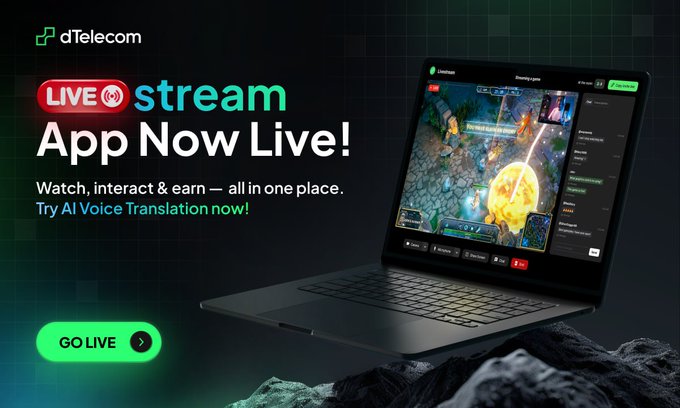Security at dTelecom: Built with Privacy & Protection in Mind
Security at dTelecom: Built with Privacy & Protection in Mind
🔒 Your Data's New Bodyguard

dTelecom emphasizes security as a fundamental aspect of their decentralized communication platform. Key features include:
- Blockchain-powered encryption for enhanced privacy
- Decentralized architecture ensuring reliable communications
- AI moderation system reducing trolls by 70%
- Support for 100K+ users with <100ms latency
- Enterprise-grade quality at 95% lower costs
The platform offers secure voice/video calls, AI-powered chat, and censorship-resistant messaging. Their recently launched AI voice agent supports 14 languages and provides automated customer support.
🚀 dTelecom.org Launches Decentralized Live Streaming with Real-Time AI Voice Translation! 📶🤖 Break free from censorship and language barriers—now you can stream to 100K+ viewers with zero risk of bans, plus instant AI translation into 30+ languages! 🌍 ⚫️No
🚀 Zero Lag, Maximum Impact: Experience Low-Latency #Communication with dMeet.org! 🌐 Did you know the fact that dTelecom, which powers dMeet, supports over 100,000 participants with < 100ms latency? 🤯 dTelecom is built for massive scalability without sacrificing
DePIN Market Set to Hit $3.5T by 2028, Surpassing Global Telecom

The **Decentralized Physical Infrastructure Networks (DePIN)** market is projected to reach **$3.5 trillion by 2028** - exceeding the entire global telecom industry's size. **Key Infrastructure Already Rebuilt:** - Storage solutions - Compute networks - Wireless infrastructure **The Missing Piece: Real-Time Communication** dTel_org aims to fill this gap with decentralized, verifiable, sub-second real-time communication (RTC). This targets the **$200 billion coordination layer** that powers internet infrastructure. **Economic Model Advantage:** When infrastructure is run by participants, operational costs transform into yield for node operators. This approach can deliver **up to 95% cost savings** compared to centralized APIs like AWS. **Revenue Distribution:** - 75% of traffic revenue goes to node operators - Increased usage drives increased capacity - Higher capacity reduces cost per gigabyte This model shifts communication infrastructure from a billable service to a **co-owned economy** where capacity pays users rather than users paying for capacity. [Read the full breakdown](https://blog.dtelecom.org/the-depin-market-explosion-why-3-5t-by-2028-changes-everything-857d388b0a87)
Frogy LIVE Powers Premium Video Through dTelecom's Decentralized Infrastructure
**Frogy LIVE** has integrated dTelecom's decentralized real-time communication (RTC) layer to power all premium video content on their platform. **Key Features:** - Scaled across continents using DePIN (Decentralized Physical Infrastructure) rails - Instant settlement in seconds - Real-time infrastructure enables real-time earnings for creators **Previous Success:** Frogy LIVE previously saved **$4,497** (85% cost reduction) by using dTelecom's infrastructure instead of traditional cloud solutions. Over two months, they processed 1.34M minutes of traffic for just $800 versus $5,297 with conventional pricing. **Impact for Creators:** The decentralized infrastructure provides creators with the tools to stream, earn, and scale their content instantly without the high costs and limitations of centralized platforms. This integration demonstrates how **DePIN technology** is making premium video streaming more accessible and profitable for content creators.
dTelecom Launches DePIN Infrastructure for Real-Time AI on Solana
**dTelecom introduces decentralized infrastructure layer for real-time AI applications** dTelecom has launched a DePIN (Decentralized Physical Infrastructure Network) layer on Solana designed to support real-time AI operations. The platform addresses a critical gap in current AI infrastructure by providing the real-time coordination needed for AI agents and applications. **Key features include:** - Live coordination loop connecting AI agents, data, and users - Sub-second latency across 4 continents - APIs and SDKs for voice, video, and screen-share integration - AI-native architecture for translation and moderation **The infrastructure challenge** While AI applications are moving to decentralized networks, most still rely on centralized communication infrastructure. dTelecom's solution provides verifiable, open-source real-time communication that can scale without vendor lock-in. The platform offers developers transparent pricing and composable tools for building applications that require live interaction and coordination. **Available now** Developers can access dTelecom's API and SDK to integrate real-time capabilities into their applications. The infrastructure supports the growing demand for AI applications that need to coordinate and communicate in real-time across decentralized networks.
dTel Launches Verifiable Routing to Solve Enterprise Communication Compliance Crisis
**83% of enterprise communications** pass through undisclosed intermediaries, violating regional data laws according to NYT's April report. The EU's DSA and UK's Online Safety Act now make companies **liable for unknown routing paths** - if your call crosses undisclosed routes, you're responsible. **dTel's solution:** - Every node staked & registered on-chain - Cryptographic proofs for each relay - Real-time auditable routes from user to ledger This shifts from *privacy by policy* to **transparency by design**. For enterprises: compliance you can prove For builders: trust you can verify Audit trails become protocols, not PDFs.
AI Computing Shifts from Cloud to Edge with Verifiable Mesh Networks

**AI infrastructure is fundamentally shifting** from centralized data centers to distributed edge computing networks. - Cisco and other $50B+ infrastructure companies are moving compute closer to users - The next decade will focus on **millions of micro-AI nodes** rather than larger cloud systems - Each node must prove its integrity in real-time through verifiable processes **dTel_org has built a solution** - a verifiable mesh network where: - Every interaction (frame, packet, inference) is cryptographically signed - All processes are timestamped and trustless by design - Real-time AI operations can maintain data integrity This shift addresses critical issues with centralized systems: - **Unacceptable latency** for real-time applications - Data sovereignty concerns - Need for local processing of sensitive information The infrastructure enables secure, decentralized computation on locally-generated data while maintaining privacy and performance standards required for physical AI applications like robots, drones, and wearables.

